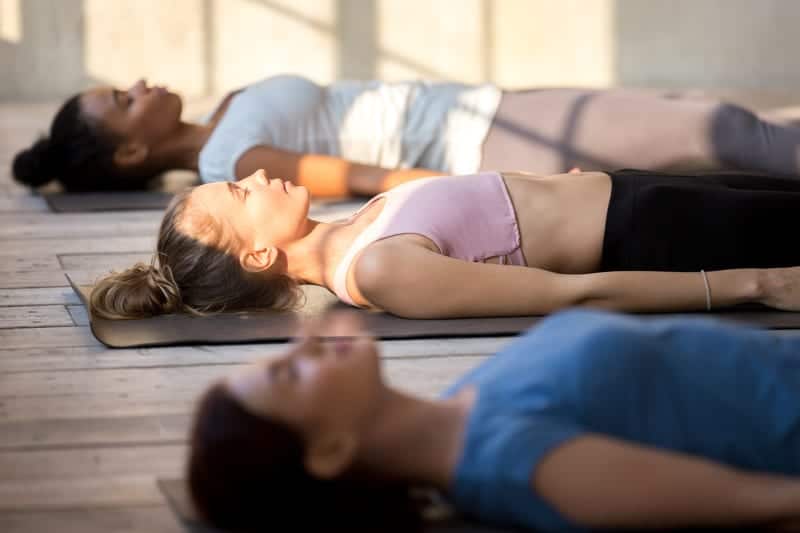
Disclosure: This post may contain affiliate links, meaning, at no additional cost to you, I may earn a commission if you click on, or make a purchase through a third-party link.
Can somatic mindfulness exercises help me?
Are they hard to learn?
What are the benefits?
Mindfulness has become a popular subject for therapists as well as those seeking self-help ideas to treat anxiety disorders and decrease stress and frustration of daily living. The COVID-19 outbreak has increased interest even more.
Mindfulness is the ability to be present in the moment without judgement. Paying attention to the simple things that we often take for granted. It is an amazingly simple idea that can really pay off.
In this post, I am going to explain a few somatic mindfulness exercises you can do to help control anxiety and improve mental health. These are simple to do and, as with most everything else, practice makes perfect. If you work on these regularly, you will find them to be very useful.

A Scan of Your Body – C. A. L. M.
This is something I practice often and I find it to be very beneficial for those times when I feel irritated or overwhelmed. This works best in a quiet place with minimal distractions. C.A.L.M. helps you remember the large zones of the body to focus on.
Before beginning, get comfortable in any position that suits you at the time. If possible, lay down. I find this to be most relaxing but understand it isn’t always convenient. Close your eyes and take a few slow deep breaths.
Chest: The first region of the body to concentrate on is your chest. Pay close attention to your breathing. Notice how your chest rises as you breathe in and falls as you exhale.
Are you breathing fast or slow?
Attempt to regulate the speed of your breathing. Keep it slow and steady. As you regulate your breath, your mind and body are also under your control. You begin to relax. Imagine your stress and anxiety leaving your body with every exhaled breath.
After a few breaths, take a deep breath and tighten all muscles in your chest. Hold this for three seconds concentrating on how it feels to be tense. Finally, allow all your muscles to relax and notice the tension leaving your body with each breath. Continue to breathe slowly and evenly as you allow your body to fully relax.
Arms: Focus on your arms. Using your mind, scan each arm from your shoulders all the way down to each fingertip.
How do your arms feel?
Are they tense, relaxed, warm, cold?
Spend a little time concentrating on just your arms. If you feel any tension, attempt to relax.
After a couple of minutes, squeeze each fist and flex all the muscles in each arm tightly. Finally, release the tension in your arms and relax each hand. Take a few breaths and notice the feeling of calmness. Let your body relax as you slowly breathe in and out.
Legs: Next, focus your mind on your legs from your hips all the way down to your toes.
How do they feel?
Are they weak, shaky, warm or cold?
Are your legs telling you anything about your level of stress or anxiety?
Begin to squeeze your muscles starting at your feet and extending up to your hips. Hold this tension for a few seconds and then release.
Notice how you feel when the tension is released. As you breathe, imagine all the tension from each leg and foot leaving your body.
Mouth: The last area to focus on is your mouth and jaw. Many of us tense muscles around our mouth when we are anxious without realizing it.
What expression is your mouth communicating?
Is this a result of stress or anxiety?
As before, clench the muscles around your mouth and jaw for a few seconds and pay close attention to the feeling. Relax your muscles and with your eyes still closed, smile.
Enjoy the feeling of relaxation as your breathing helps to remove stress from your body.
Continue to breathe is this relaxed state thinking about the areas where you noticed evidence of stress and anxiety or tension. As you breathe, imagine the tension leaving your body with each breath.
This exercise can be a life-changing skill once developed. With practice, you will be able to close your eyes and imagine the stress and tension leaving your body just by breathing.
You can train yourself to identify tension in different areas of your body and remove it using your mind.

Grounding Exercises
Heel drops: In this exercise you will start by standing. Slowly lift up your heels so you are standing on your toes. Return to your standing position. Do this repeatedly in a slow, rhythmic pattern. Pay attention to how your hips and lower back feel while doing this exercise. Each time you return to a standing position, imagine stress and tension leaving your body.
Bamboo Swaying: In this exercise you will stand and allow your body to slowly sway back and forth like a bamboo in the wind. The rocking motion helps to relieve tension. If you feel little tremors through your body while doing this exercise, do not be alarmed. This is one of the ways your body releases tension.
It is important to take a moment to scan your body after these grounding exercises to see how you feel.
Do you feel more grounded?
More connected to the earth below?
Do you feel less tension or stress?

Other Ways to Practice Mindfulness
In today’s society, most of us are used to doing more than one thing at a time. This can lead to frustration, anxiety, burnout and even depression. Trying to take care of our families, get our work done, prepare meals and keep the house clean can feel overwhelming. One of your goals should be to try to do one thing at a time. This can be learned by taking small steps.
Make a list of what needs to be done starting with the most important tasks. Begin with the first task on the list and try to let go of distractions that come your way. I suggest silencing your cell phone and computer email during this time.
If you find yourself worrying about different things or thinking about something else, take a few deep breaths and imagine those thoughts leaving your mind with your breathing. If you find yourself doing more than one thing at a time, stop, and choose the thing on the top of the list and return to it. This can be difficult at first but will become easier with practice.
Tell your intrusive thoughts to leave your mind. Keep doing this until you get results. There are several exercises that can be done to help you succeed. Start to notice times where you are thinking about one thing only.
How does this feel?
Here are a few things that can be done to practice focusing on one thing only. Try to do these exercises several times each day, especially when you are feeling stressed or overwhelmed.
- Watch a fire. This can be in your fireplace or a campfire. Don’t think about anything, just watch.
- Watch the raindrops running down a window.
- Listen to the ticking of a clock.
- Listen to the ocean waves.
- Breathe mindfully as explained above.
- Watch trees blowing in the wind.
I also like to take a walk outside and observe nature when I get stressed. Concentrating on something as simple as the beauty of a leaf or the bark on a tree can change your mindset.

With practice, somatic mindfulness can become an important tool to fight stress, anxiety, depression and burnout. We started with breathing which I believe to be a very important first step to calm the body. A few months ago I wrote a post on anxiety. This would be a great time to review that article. It has more information on breathing techniques and other ideas to help relieve stress and anxiety. When these exercises aren’t enough, don’t forget about our Anxiety Formula. This is the best-selling product in our store and our customers love it. Take a look at this video recorded by a friend of mine who uses the product.
We can all live a more productive, enjoyable life if we take some simple steps to take care of our mind and body. You are reading this because you are committed to be a happier and healthier person. Remember what I have been telling you all:
- Get plenty of sleep.
- Drink eight, 8 ounce glasses of water daily. More if you are sweating (exercise or hot weather).
- Eat whole foods – stay far away from fast food, junk food and empty calories.
- Exercise – Stay active. Find an exercise you like and do that activity for at least 30 minutes, 5 days per week.
- Avoid alcohol and drugs. If you need a reminder why you shouldn’t drink alcohol, read my article on ethanolism.
- Think positively and surround yourself with positive people.
- Spend as much time with your happiness elements as possible!
That is all for this week. I hope you are all staying safe during this COVID-19 outbreak. PLEASE STAY HOME if you are not an essential worker. This virus has turned out to be worse than we initially thought.
Wash your hands often,
maintain a six-foot distance from others, and
stay isolated until this virus runs its course.
We will get through this.
If you have any questions or comments, please feel free to contact me. I welcome any interaction from my readers. This blog is for you!

Michael J. Brown, RPh, BCPS, BCPP
Mr. Brown is a Clinical Pharmacist specializing in pharmacotherapy and psychiatry.
Feel free to send Michael a message using this link.

